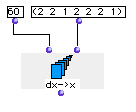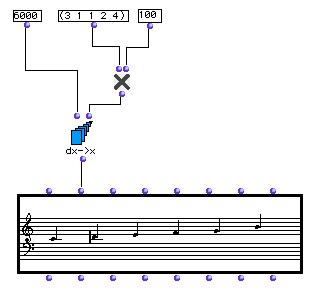OpenMusic Reference
dx->x

dx->x
(series module) -- constructs a list of numbers from start with intervals given by list .
Syntax
dx- >x start list
Inputs
| name | data type(s) | comments |
|---|---|---|
| start | a number | the starting point of the new list |
| list | a list of numbers | the intervals between elements of the new list |
Output
| output | data type(s) | comments |
|---|---|---|
| first | a list of numbers |
Description
This function is the complement of x->dx
dx->x takes its name from the mathematical notation for the change over time in a given quantity. This change in time is usually symbolized by the greek letter delta: Δ. It is also notated with a d and the variable whose change over time is being measured, frequently x , i.e. dx.
dx->x takes a list of relative intervals and converts it into a series of absolute values starting at start . The list returned will thus have one more element than the list input.
Examples
Reconstructing a series from a list of deltas

The function will start at 60 and add the numbers in list consecutively, with the result:
? OM->(60 62 64 65 67 69 71 72)
Reconstructing a melody from a list of intervals

Here we reconstruct the melody of the example given in the reference for x->dx .
A list of intervals in semitones, (3 1 1 2 4), is passed to the function along with the starting point, middle C (whose midic is 6000), after being multiplied by 100 to convert them to midics.
They are converted into values relative to the initial note, midic 6000 (6000 6300 6400 6500 6700 7100) and then passed to the lmidic input of the Chord-seq object. The melody is reconstructed.
| Prev | Home | Next |
|---|---|---|
| denominator | Up | equal |